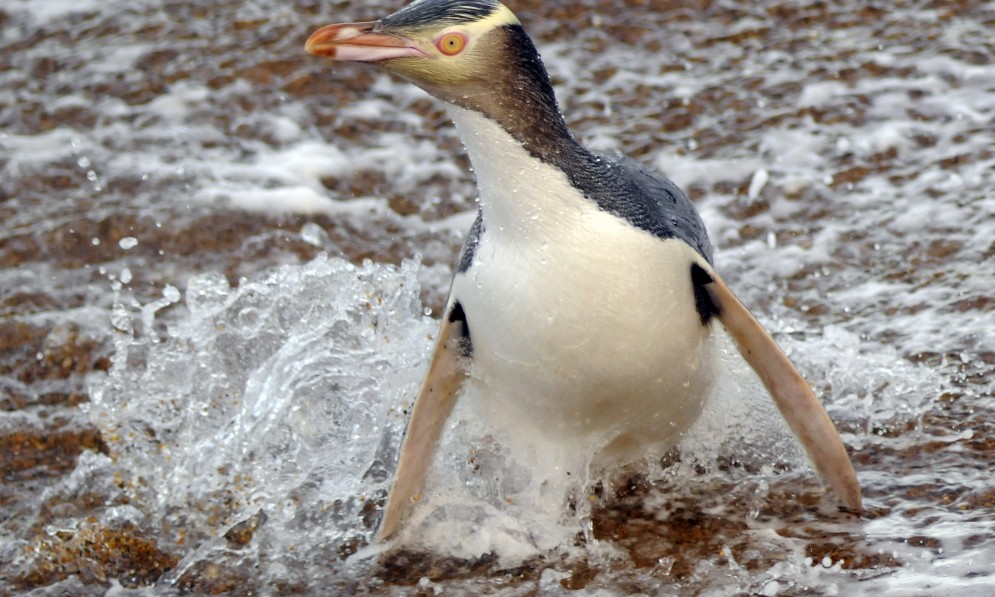Nearly half the breeding population of endangered hoiho (yellow-eyed penguins) on the island sanctuary of Whenua Hou (Codfish Island) have disappeared at sea, and Forest & Bird says the evidence indicates they most likely drowned in a commercial set net.
Forest & Bird is calling on the Government to urgently call together Ngāi Tahu, the Department of Conservation, the Ministry of Primary Industries, community organisations and scientists who work to protect hoiho.
"We're also calling on the fishing industry to agree an immediate set of actions to eliminate the risks from set netting in the penguins' feeding areas," says Forest & Bird Chief Executive Kevin Hague.
Hoiho are the world’s most endangered penguin species, whose breeding numbers in the South Island have been falling year on year since 2005. This year, alongside continued decline across all their mainland nesting colonies, a scientific survey has shown that nearly half the birds from the sanctuary island Whenua Hou have disappeared.
"This bird is so special that it appears on New Zealand’s five dollar note. The critical information about the Whenua Hou catastrophe should not have been held back from the public. Instead we need honest conversation with New Zealanders spelling out the actions that will be taken to prevent it happening again.
“Unlike previous years where disease and high temperatures caused deaths on land, this year birds have disappeared at sea. There is an active set net fishery within the penguins’ Whenua Hou foraging ground, and the indications are that nearly half the Whenua Hou hoiho population has been drowned in one or more of these nets.
“We are asking DOC and MPI what they intend to do to save our hoiho from extinction, because at current rates of decline we are on track to lose hoiho completely from mainland New Zealand. We have also written to the Minister of Conservation, expressing our concern.
"Why is the Recovery Plan for hoiho still not written? Why has MPI not convened the working group on managing threats to hoiho from the fishing industry?" asks Mr Hague.
Earlier this year, Forest & Bird released data from MPI that showed only 3% of the set net fishery had MPI observers on board, yet nearly all recorded penguin deaths came from the tiny minority of boats with observers.
“It's simply unbelievable that almost every penguin killed in the set net fishery was killed on a boat that had an official observer on board. As a first step, MPI needs to get more of their observers onto set net vessels and prioritise putting cameras on set netting boats.
“Responsible set netters need to ask the question of their fellow fishers - why is it that the only recorded bykill of penguins appears to be on monitored fishing vessels?” says Mr Hague.
As well as the disappearance of nearly half the hoiho on Whenua Hou, hoiho have also declined elsewhere this year:
- The Catlins, a traditional hoiho stronghold, has seen a drop of 10% in nests
- Otago Peninsula has shown a small (provisional) decline but not all areas have been searched yet
- The estimate for the entire southern east coast of the South Island is down 6%.
Preliminary survey numbers as provided by the Yellow Eyed Penguin Trust:
Most of this year’s nest searches have now taken place, so we can give a preliminary assessment of trends though we are not yet able to confirm the final number by site or provide a more definitive season estimate for the southern South Island. As a basic summary, it looks like nest numbers are similar to last year from Dunedin northwards, but there are declines further south.
- North Otago 50 nests at Moeraki, a similar number to last year.
- Peninsula has estimate of 90 nests and is trending slightly down on last year (-2%). Papanui Beach and Kumokumowhero (Penguin Beach) are the large sites still to be searched and could still change this preliminary estimate considerably.
- Catlins show a decline with the current estimate of 108, down 10% from the 120 nests estimated last year.
The estimate for the total southern east coast based on current counts is 246, down from 261 - a 6% decline.
More concerning are the results from Whenua Hou (Codfish Island) where only 14 nests were found (24 last year). Nest counts of Yellow Eyed Penguins on Whenua Hou/Codfish Island have been steadily declining with a sharp decrease in the number of nests found this year. As Whenua Hou is a predator free island, terrestrial influences are unlikely to be the cause. More research is needed on the factors affecting the population of hoiho on Whenua Hou.

